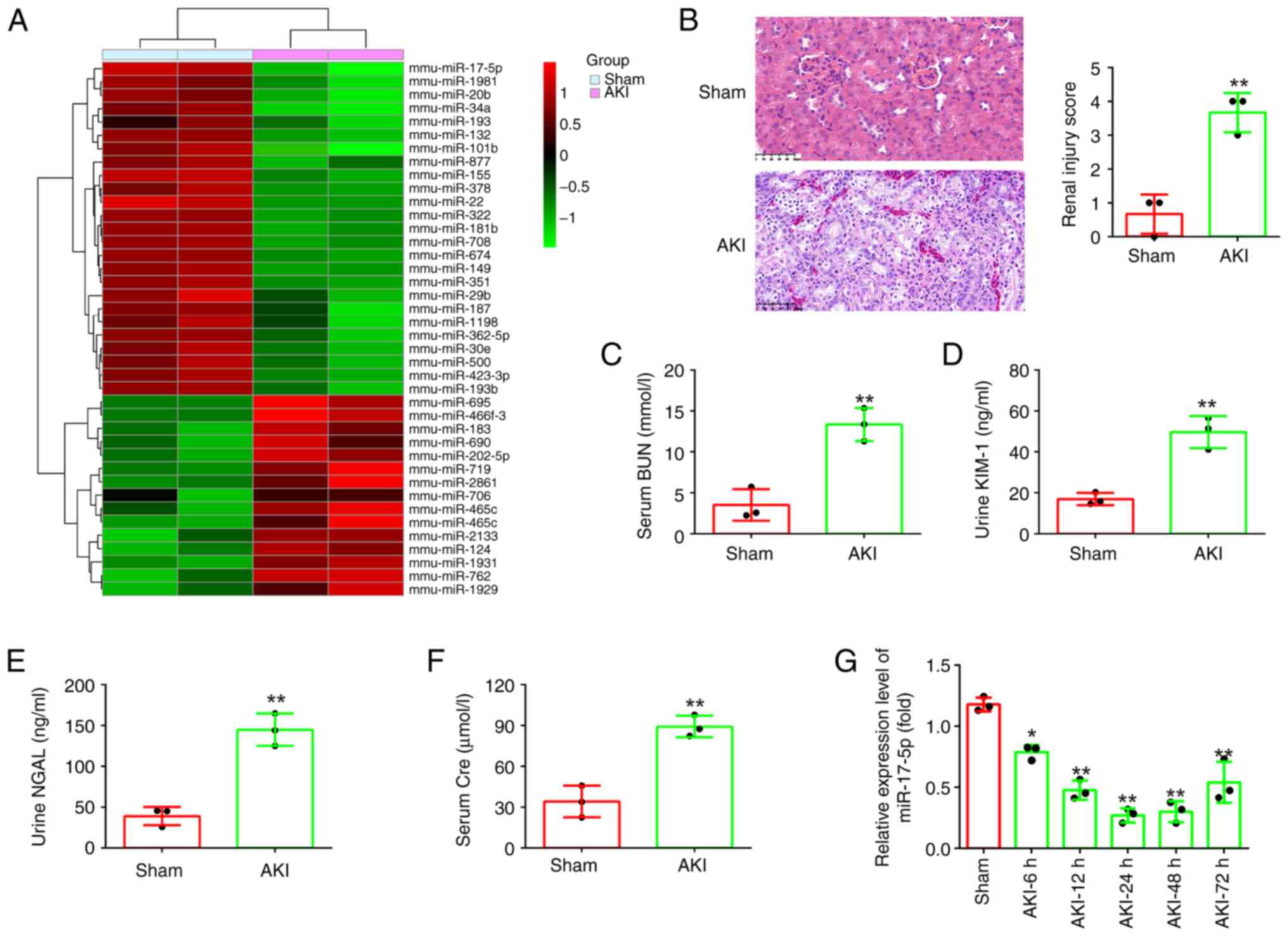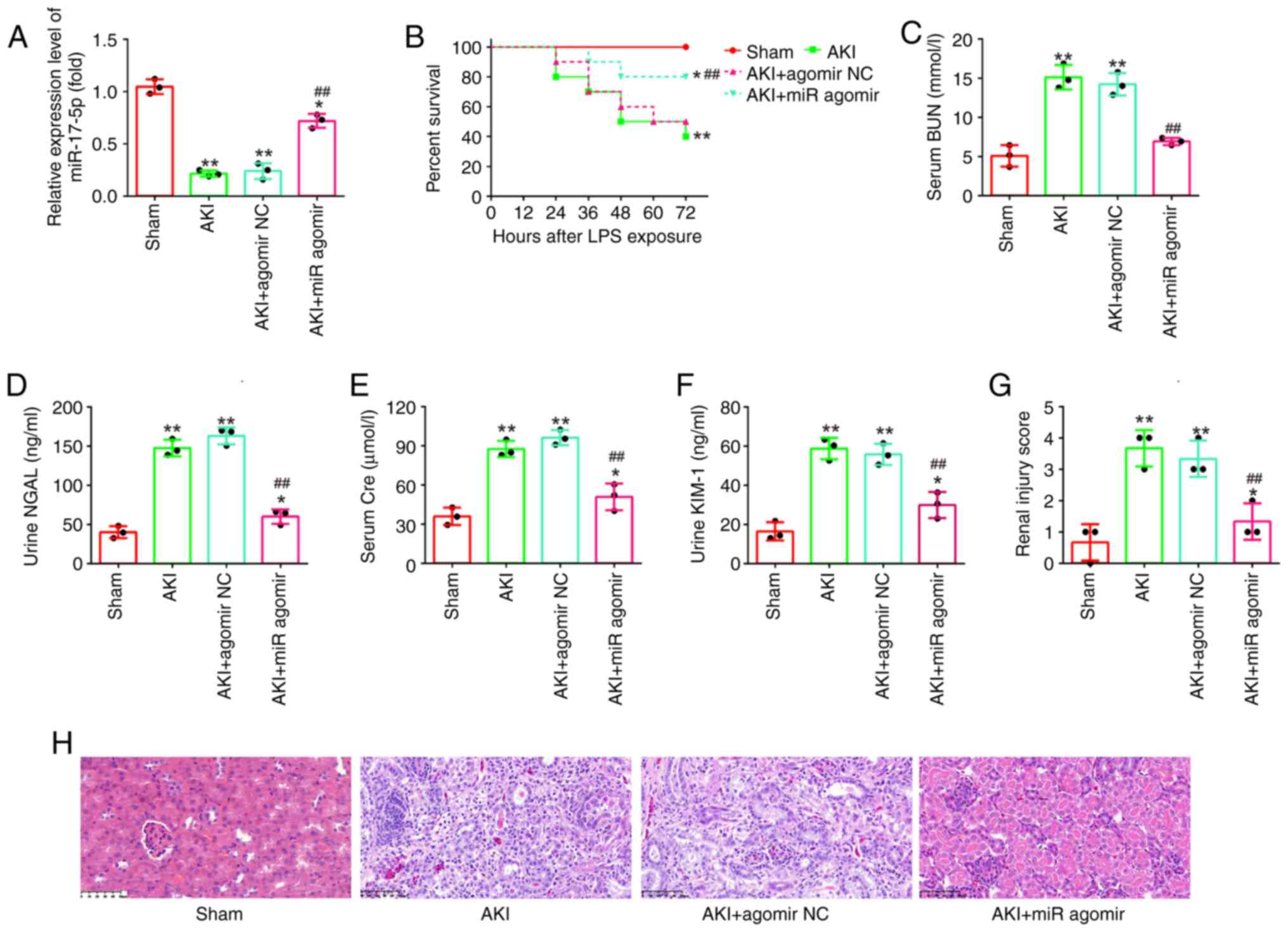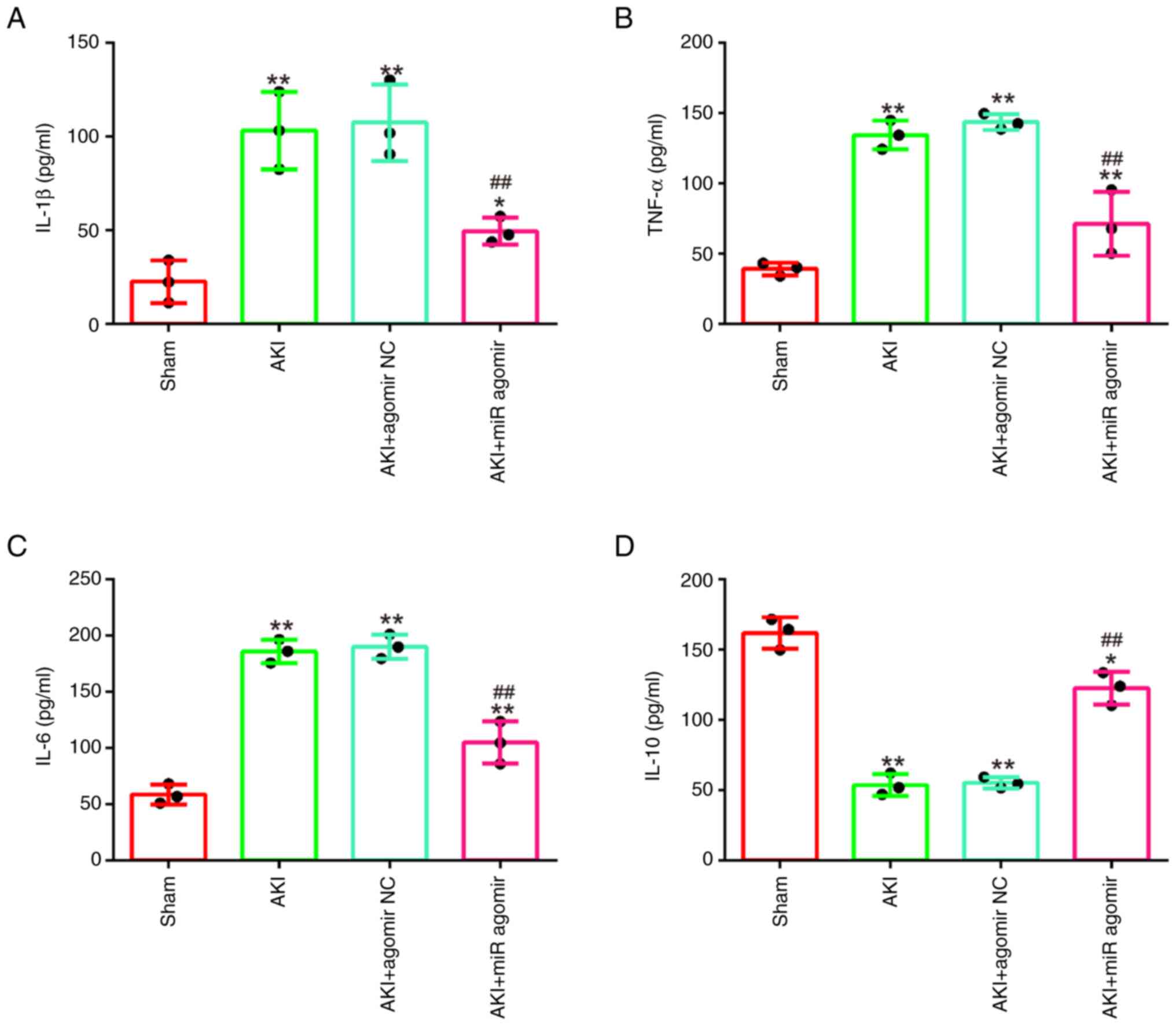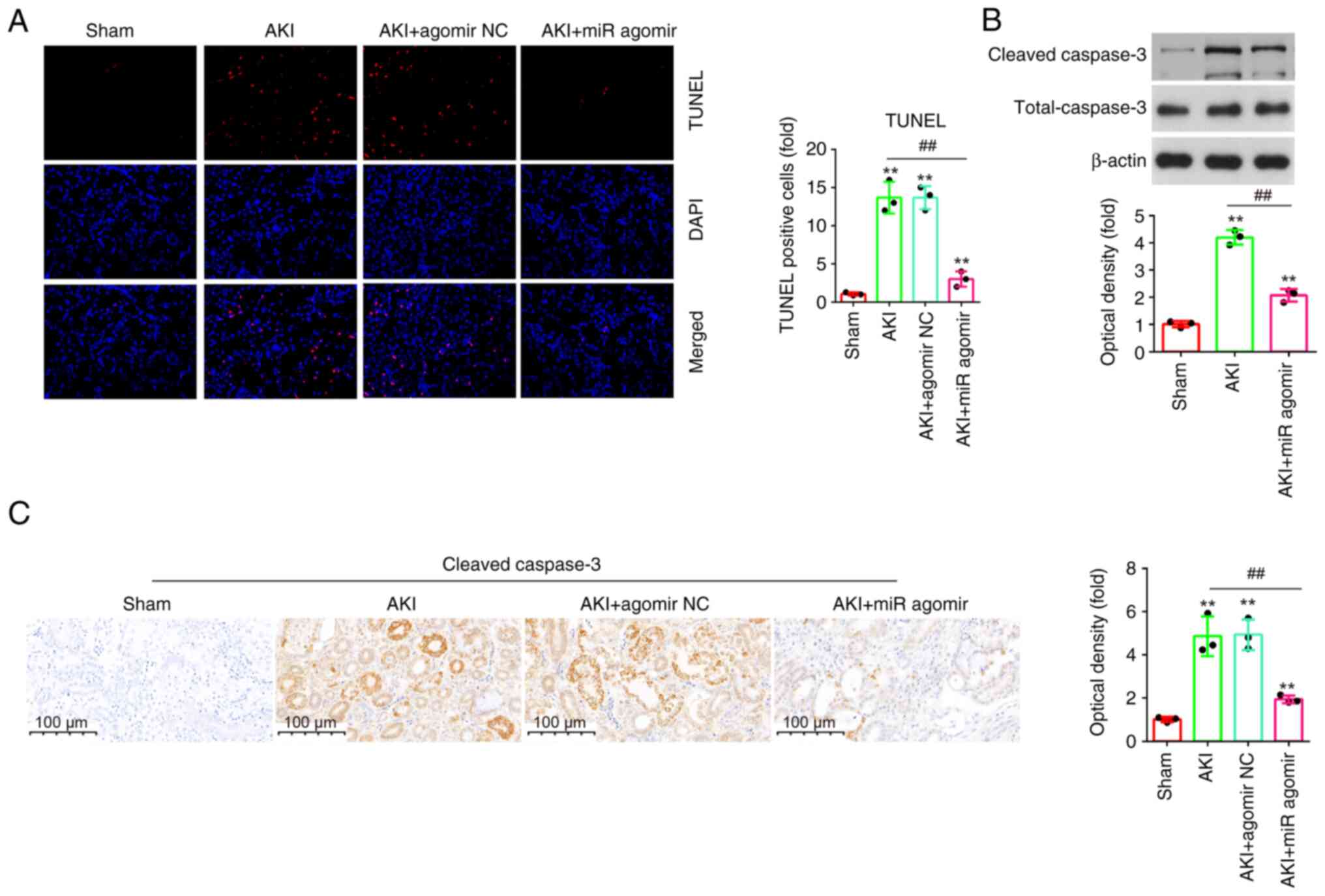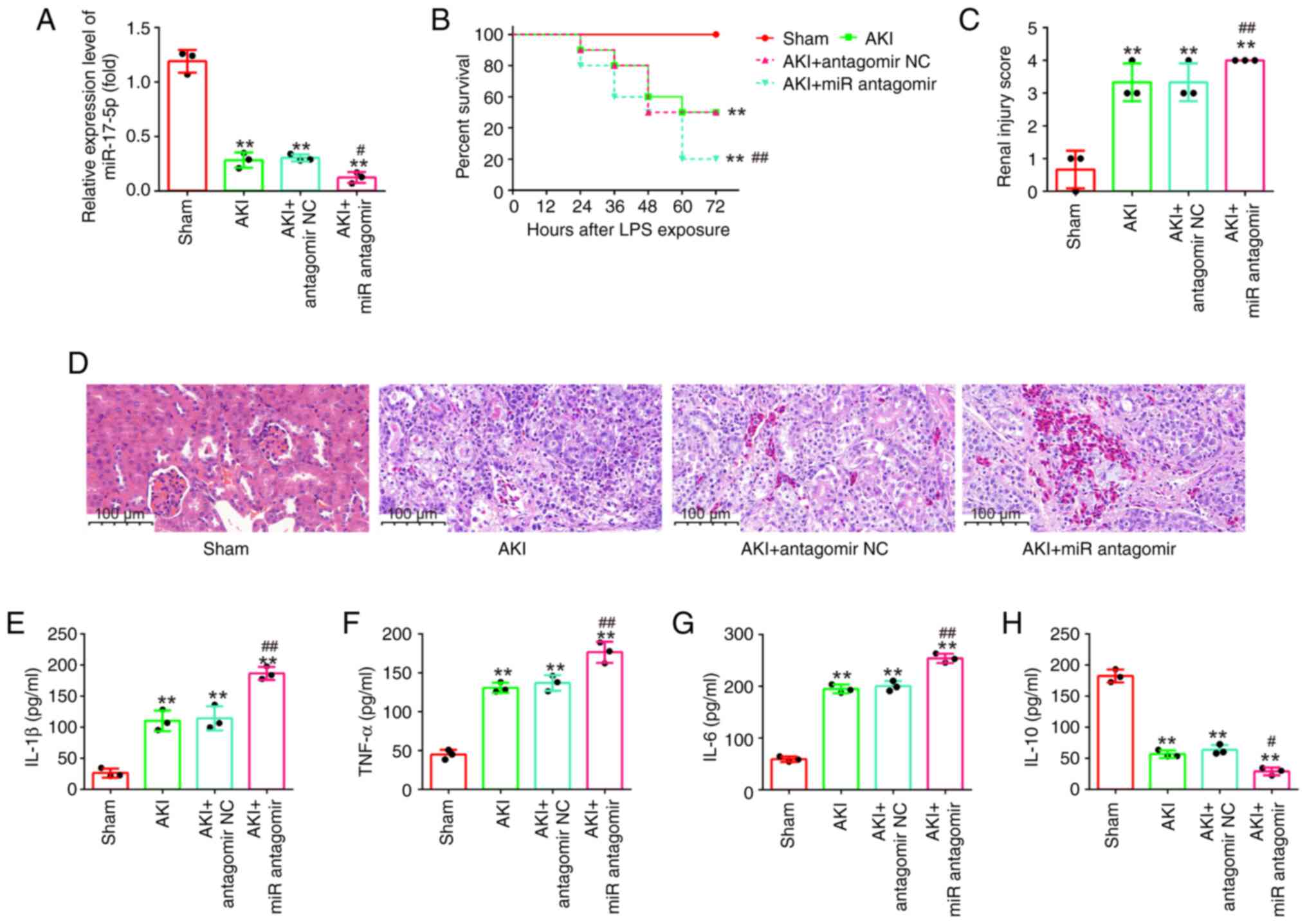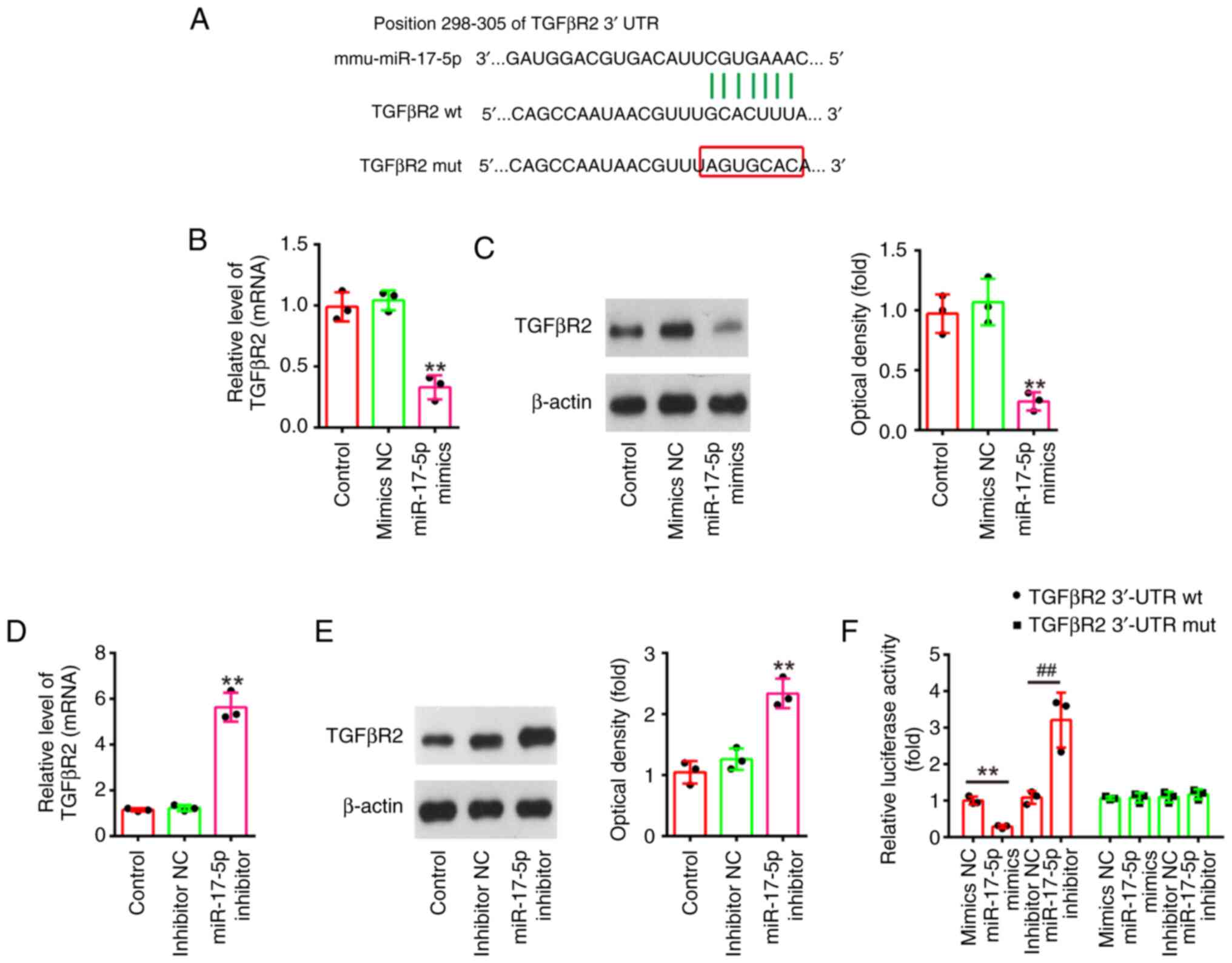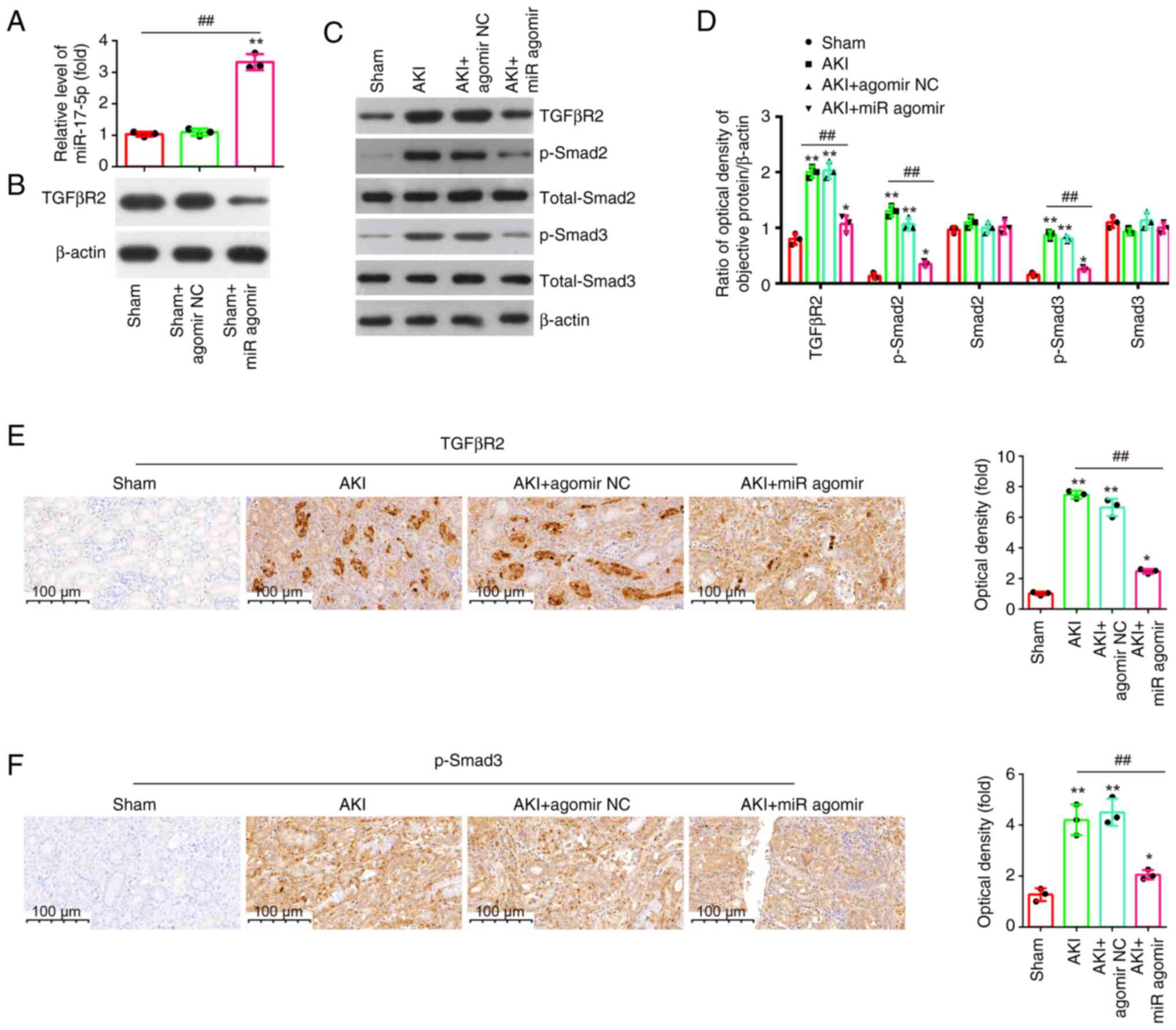MicroRNA‑17‑5p alleviates sepsis‑related acute kidney injury in mice by modulating inflammation and apoptosis
- Authors:
- Published online on: June 14, 2024 https://doi.org/10.3892/mmr.2024.13263
- Article Number: 139
-
Copyright: © Sun et al. This is an open access article distributed under the terms of Creative Commons Attribution License.
Abstract
Introduction
Sepsis is a common and frequently fatal condition that is one of the main causes of multiple organ failure (1). Acute kidney injury (AKI) caused by sepsis is the most common organ failure symptom with a mortality rate of up to 70% (2,3). It has been reported that patients with severe AKI eventually develop renal failure, bringing serious threaten to the life of individuals and huge economic burden (4,5). Therefore, there is an urgent requirement regarding effective therapeutic targets of sepsis-induced AKI.
The pathogenesis of sepsis-induced AKI is clearly complex and multi-factorial, including inflammation, oxidative stress and autophagy, but definitely also involves the apoptosis of renal tubular cells (6,7). Renal biopsy specimens in patients with sepsis provided evidence of pronounced renal tubular apoptosis, suggesting that sepsis-induced apoptosis is closely associated with kidney failure (8). It was also reported that unconscionable apoptosis of renal tubular cells can exacerbate sepsis and increase the mortality rate of patients (9). Zhu et al (10) found that baicalin improved sepsis-induced AKI through suppressing renal cell apoptosis in AKI mice model. Another study demonstrated that geniposide could ameliorate AKI through suppressing cell apoptosis in vivo and in vitro (11). Therefore, inhibition of renal tubular cells apoptosis may be an effective way to improve sepsis-induced AKI.
MicroRNAs (miRNAs or miRs) are nucleotide regulatory RNA molecules (18–24 bases in length) that regulate gene expression post-transcriptionally via binding to the 3′-untranslated region (UTR) of target mRNAs (12,13). It is well-known that miRNAs are involved in almost all biological processes via the direct post-transcriptional inhibition of target mRNAs. They are estimated to regulate >60% of human protein-coding genes. Importantly, miRNAs have been found to modulate multiple target genes involved in distinct cellular processes, including signal transduction, proliferation and apoptosis. Thus, the dysregulation of the miRNA network contributes to numerous pathological processes, including cancer, cardiovascular disease and AKI (14,15). Numerous studies have reported that miRNAs are differently expressed in the plasma or urine of patients with AKI, such as miR-155 and miR-21 in plasma, miR-192-5p in urine, suggesting that they could be used as biomarkers for the diagnosis of AKI (16–18). Furthermore, several miRNAs have been identified to have a pathogenic or protective role in kidney injury. For example, enhanced miR-93 led to a significant reduction in the tubular epithelial cell apoptosis via the AKT/mTOR pathway in AKI (19). Additionally, inhibition of miR-155 could improve kidney injury by regulating apoptosis under ischemia-reperfusion (I/R) condition (20). A previous study also reported that upregulation of miR-21 could ameliorate I/R-induced kidney injury by inhibiting renal tubular epithelial cell apoptosis (21). Therefore, exploring novel miRNAs as the therapeutic targets may be the important ways to regulate sepsis-induced AKI.
In the current study, the differentially expressed miRNAs in microarray dataset GSE172044 were analyzed. The functions of candidate miRNA were investigated in mouse AKI model and the involved molecular mechanisms were further examined.
Materials and methods
Animal model
A total of 96 female C57BL6/J mice (Shanghai SLAC Laboratory Animal Co. Ltd.), aged 10–12 weeks, weighing 18–22 g, were housed under standard conditions (12/12-h light-dark cycle, 21±2°C, ~55% humidity) with free access to food and water. The experimental mice were acclimatized for 7 days, anesthetized by an intraperitoneal injection of 50 mg/kg pentobarbital sodium (Sigma-Aldrich; Merck KGaA), and each mouse was administered intraperitoneally with 10 mg/kg body weight lipopolysaccharide (LPS; from Escherichia coli 0111:B4; Sigma-Aldrich; Merck KGaA) as previously described (22,23). The present study was approved by the Animal Experimentation Ethics Committee of the Xinhua Hospital Affiliated to Shanghai Jiao Tong University School of Medicine (Shanghai, China; approval no. SJTU 2022-012).
Experimental design
Animals were randomly divided into two groups: AKI and Sham group (n=6 each group/time) were subjected to the miR-17-5p expression using the reverse transcription-quantitative PCR (RT-qPCR) at 6, 12, 24, 48 and 72 h after AKI.
In the following experiment, mice were randomly divided into six groups: AKI group, Sham group, AKI + agomir-miR-17-5p group, AKI + agomir-negative control (NC) group, AKI + antagomir-miR-17-5p group and AKI + antagomir-NC group (n=6). Mice in the AKI group were subjected to 200 µl LPS (10 mg/kg) in PBS intraperitoneally (n=6/group/time), while mice that did not receive any treatments were used as the Sham group. In AKI + antagomir-miR-17-5p/agomir-miR-17-5p groups, each mouse was administered antagomir or agomir-miR-17-5p (20 nM/0.1 ml) by tail-vein injection before 24 h of LPS injection. A total of 24 h after the last treatment, all mice were humanely killed with intraperitoneal injection of pentobarbital sodium (50 mg/kg; Sigma-Aldrich; Merck KGaA) to collect blood by heart puncture, as well as urine and kidney samples.
In another animal experiment, survival outcomes of septic mice with antagomiR-17-5p/agomir-miR-17-5p (20 nM/0.1 ml) treatment was observed from 0 to 72 h after LPS injection using the Kaplan Meier methods (n=10/group).
Pentobarbital sodium (50 mg/kg, intraperitoneal injection) was used for anesthesia before each operation, and all efforts were made to minimize animal suffering. The mice health and behaviour were monitored twice a day. No mice succumbed during anesthesia process. If an animal reached the defined humane endpoints [loss of >15% of body weight in 1–2 days or an overall reduction of >20% in body weight or displaying obvious signs of suffering (lethargy, squinted eyes, dehydration, hunched back)], they were humanely euthanized. Sacrifice was performed by intraperitoneal injection of pentobarbital sodium (50 mg/kg) followed by cervical dislocation, and animal death was confirmed by cessation of respiration and heartbeat.
Renal function measurement
After 24 h of modeling, serum blood urea nitrogen (BUN) and creatinine (Cre) levels were detected by using an automated analyzer (Roche Diagnostics GmbH) and a creatinine assay kit (cat no. E2CT-100; BioAssay Systems), respectively. The kidney injury molecule-1 (Kim-1) and neutrophil gelatinase-associated lipocalin (NGAL) levels of urine samples were measured by ELISA kits (cat nos. RKM100 and DY3508; R&D Systems, Inc.) based on the manufacturer's protocol.
Renal histopathology
The hematoxylin and eosin (H&E) staining was used to measure the pathological changes in mouse kidney tissues. Tissue changes was checked and scored as previously described (24).
Detection of renal cell apoptosis
Renal tissue sections were prepared as aforementioned; apoptosis was quantified in tissue sections by the TUNEL assay kit (cat no. C1086; Beyotime Institute of Biotechnology) according to the manufacturer's instructions. The numbers of TUNEL positive cells were quantified under adjacent 10 fields using a fluorescence microscope (Olympus Corporation).
Immunohistochemistry (IHC)
Paraffin embedded sections were dewaxed with xylene at 50°C for 3 min, hydrated by graded ethanol series, and then incubated in 3% hydrogen peroxide at room temperature (RT) for 15 min to inactivate endogenous peroxidase. After washing with phosphate-buffered saline (PBS), the sections were blocked with 10% fetal bovine serum (FBS, Gibco; Thermo Fisher Scientific, Inc.) at RT for 30 min, and subsequently incubated with primary antibodies against cleaved caspase 3 (1:200; cat. no. ab32042), transforming growth factor β receptor 2 (TGFβR2; 1:200; cat. no. ab186838) and phosphorylated (p-) Smad3 (1:100; cat. no. ab52903; all from Abcam) overnight at 4°C. After washing with PBS, the slices were incubated with EnVision + /HRP/Rb (DAKO; Agilent Technologies, Inc.) for 30 min at 37°C. The staining was observed with 3,3′-diaminobenzidine (DAB) matrix, and then reverse stained with hematoxylin for 30 sec. Images of all sections were captured with Olympus BH2 microscope (Olympus Corporation).
MicroRNA expression profile data from Gene Expression Omnibus (GEO)
The miRNA dataset (GSE172044) was downloaded from the GEO database in NCBI (https://www.ncbi.nlm.nih.gov/geo/query/acc.cgi?acc=GSE172044), and the differentially expressed miRNAs were identified using the ‘limma’ package in R (25). The fold changes (FCs) in the expression of individual miRNAs were calculated, and |log2FC|>1.0 and P<0.05 were regarded as the thresholds of differentially expressed miRNAs. The heat map was generated with the Nexus Expression (Ver.10.0. BioDiscovery Inc.).
RT-qPCR analysis
Target miRNA was extracted from spinal tissues using TRIzol® (Invitrogen; Thermo Fisher Scientific, Inc.). miR-17-5p and mRNA were reverse transcribed using a Reverse Transcription kit (Takara Bio, Inc.) and PrimeScript RT Reagent kit (Takara Biotechnology Co., Ltd.) according to the manufacturer's instructions, respectively. For detection of miR-17-5p, qPCR was performed using TaqMan™ MicroRNA Assay kit on the ABI PRISM 7300 system (Applied Biosystems; Thermo Fisher Scientific, Inc.). U6 was used as internal control. Primers used for miR-17-5p and U6 were as follows: miR-17-5p forward, 5′-GGCAAAGTGCTTACAGTGC-3′ and reverse, 5′-GTGCAGGGTCCGAGG-3′; and U6 forward, 5′-GCTTCGGCAGCACATATACTAAAAT-3′ and reverse, 5′-CGCTTCACGAATTTGCGTGTCAT-3′. For mRNA detection, qPCR was conducted using a SYBR Premix Ex Taq II kit (Takara Bio, Inc.). Primer sequences were as follows: TGFβR2 forward, 5′-TGTGAGAAGCCGCAGGAAGTC-3′ and reverse, 5′-AGTGAAGCCGTGGTAGGTGAAC-3′; and GAPDH forward, 5′-GGCAAGTTCAACGGCACAGTCAAGG-3′ and reverse, 5′-CACGACATACTCAGCACCAGCATCAC-3′. GAPDH was used as internal controls for detecting TGFβR2. The qPCR thermocycling conditions were as follows: 95°C for 30 sec, followed by 40 cycles at 95°C for 5 sec and 60°C for 30 sec. The reaction volume was 25 µl. Fold changes in expression of each gene were calculated through the 2−∆∆Cq method (26).
Measurement of cytokines
Mouse ELISA kits were used to quantify the inflammatory cytokines, including interleukin-6 (IL-6) (cat. no. p1326), IL-1β (cat. no. p1301), tumor necrosis factor-α (TNF-α) (cat no. pt512) and IL-10 (cat. no. p1522) in serum according to the manufacturer's protocols. These kits were obtained from Beyotime Institute of Biotechnology.
Cell culture
NRK-52E cells (https://www.cellosaurus.org/CVCL_0468) were maintained routinely in Dulbecco's modified Eagle's medium (DMEM) supplemented with 10% bovine calf serum, 1,000 U/ml penicillin, and 1,000 µg/ml streptomycin. For 293T cells, DMEM was supplemented with 10% FBS. Cells were grown in a humidified atmosphere of 95% air and 5% carbon dioxide at 37°C in a tissue culture incubator.
Bioinformatics analysis
Target genes were predicted through different bioinformatics databases, including TargetScan 7.0 (https://www.targetscan.org/vert_80/) and miRanda (http://www.microrna.org/microrna/home.do).
Luciferase assay
The TGFβR2 wild-type (WT) sequences or mutant (mut) sequences in 3′-UTR containing the miR-17-5p binding site were constructed and subcloned into the pGL3 basic plasmid (Promega Corporation). For dual-luciferase reporter assay, when 293T cells (1×105 per well; ATCC) reached ~60% confluence were seeded in a 96-well plate, recombinant plasmids were co-transfected with the miR-17-5p mimics (5′-CAAAGUGCUUACAGUGCAGGUAG-3′), mimics NC (5′-CAGCUAGAGUAUACGCUUGAAGG-3′), miR-17-5p inhibitor (5′-CUACCUGCACUGUAAGCACUUUG-3′) or inhibitor NC (5′-CGUUCUAAGUCACUUCACACUGG-3′) (Shanghai GenePharma Co., Ltd.) using Lipofectamine® 3000 (Thermo Fisher Scientific, Inc.). After 48 h of transfection, luciferase activity was measured using the Dual-Luciferase Reporter Assay system (Promega Corporation) and normalized to Renilla luciferase activity. pRL-TK plasmid was transfected as an internal control.
Western blotting
Kidney tissues were homogenized in homogenization buffer (Thermo Fisher Scientific, Inc.) and centrifuged at 12,000 × g, for 10 min at 4°C, and then the protein concentrations were measured using the BCA protein assay kit. Next, equal amounts of proteins (50 µg/lane) were separated on 10% gels using SDS-PAGE and electrotransferred onto polyvinylidene fluoride membranes. After transferring on a PVDF membrane (MilliporeSigma), the membranes were blocked with 5% skim milk for 2 h at room temperature (RT). After washing with PBST (0.1% Tween-20) three times, membranes were incubated with primary antibodies including cleaved caspase 3 (1:2,000; cat. no. ab32042), TGFβR2 (1:2,000; cat. no. ab186838), p-Smad3 (1:1,000; cat. no. ab52903) and β-actin (1:1,000; cat. no. ab6276; all from Abcam) at 4°C overnight. Subsequently, membranes were incubated with the secondary antibody goat anti-Mouse IgG H&L (Alexa Fluor® 488; 1:2,000; cat. no. ab150117; Abcam) for 2 h at RT. The bands were exposed by enhanced chemiluminescence (ECL) (Thermo Fisher Scientific, Inc.) and analyzed by ImageJ Software (version 1.46; National Institutes of Health).
Statistical analysis
SPSS Statistics 22.0 (IBM Corp.) was used for all statistical analysis. All data are presented as the mean ± SD. The comparison between multiple groups was analyzed by one-way ANOVA followed by Tukey's post hoc test. Kaplan Meier method was used for survival analysis, and log rank test was used to calculate the P-value. P<0.05 was considered to indicate a statistically significant difference.
Results
miR-17-5p is significantly downregulated in kidney tissues of AKI mice
First, the miRNA profile (GSE172044) downloaded from the GEO database was analyzed. Compared with the Sham group, 40 differentially expressed miRNAs were identified, among which miR-17-5p was one of the most downregulated miRNAs (Fig. 1A). Previous studies have revealed that miR-17-5p has a critical role in multiple organ injuries, including cardiac I/R injury, spinal cord injury and renal I/R injury (27–29). Of relevance, a recent study demonstrated that miR-17-5p elevation protected renal cells from LPS-induced injury by suppressing inflammatory response and apoptosis in LPS-stimulated HK-2 cells (30). However, few studies have been found regarding the function of miR-17-5p in the progression of sepsis-induced AKI.
In order to study the role of mir-17-5p in AKI, a mouse AKI model was established. Initially, the pathological change in the renal tissue of mice was assessed using H&E staining assay. The results indicated that the renal tissue of the AKI group exhibited tubular epithelial cell edema, tubular necrosis, telangiectasia and severe congestion/hemorrhage compared with the sham operation group (Fig. 1B). Meanwhile, the levels of BUN, KIM-1, NGAL and Cre that were specific biomarkers of kidney injury (31,32), were found to be significantly increased in the AKI group compared with that in the sham group (Fig. 1C-F). Correspondingly, the renal injury scores were significantly higher in the AKI group than that in the sham group (Fig. 1B). These results indicated that the model of mice with AKI was successful established.
Next, miR-17-5p expression was detected in AKI mice by RT-qPCR. It was identified that miR-17-5p was continuously decreased, and was minimal at 24 h after AKI, then its expression was gradually increased until 72 h after injury (Fig. 1G). Collectively, these results suggested that miR-17-5p may be involved in the pathogenesis of AKI.
AgomiR-17-5p improves LPS-induced kidney injury in mice
To further examine the impact of miR-17-5p in AKI, miR-17-5p upregulation was performed in an in vivo experiment by injecting agomiR-17-5p into mice via the caudal vein followed by LPS stimulation for 24 h. Using RT-qPCR, it was found that the expression levels of miR-17-5p were significantly increased after agomiR-17-5p treatment (Fig. 2A). In addition, the mice in the agomiR-17-5p + AKI group had a higher survival rate than that in AKI group (Fig. 2B). Subsequently, the altered kidney injury was evaluated. The results revealed that miR-17-5p overexpression significantly decreased the levels of BUN, KIM-1, NGAL and Cre expression in the septic mouse model (Fig. 2C-F). In the results from H&E staining, injection of agomiR-17-5p significantly reduced the edema of the glomerular tissue cells, tubular necrosis, telangiectasia, as well as the severe congestion/hemorrhage. The renal injury scores were significantly lower in the AKI + agomiR-17-5p group than that in the AKI group (Fig. 2G and H). Collectively, all data indicated that enhancing miR-17-5p could alleviate LPS-induced kidney injury in vivo.
AgomiR-17-5p alleviates the inflammatory response in LPS-induced AKI mouse model
It was further examined whether miR-17-5p affects the inflammatory response in AKI mice model. As demonstrated in Fig. 3A-D, LPS stimulation significantly increased the levels of IL-1β, TNF-α and IL-6, and decreased IL-10 levels compared with the sham group, which suggested that excessive inflammatory response occurred in mice during AKI. On the contrary, agomiR-17-5p significantly decreased the production of IL-1β, TNF-α and IL-6 and increased IL-10 expression levels compared with the AKI group. All these data indicated that enhancing miR-17-5p exerts protective role through alleviating inflammatory response in AKI.
AgomiR-17-5p suppresses apoptosis in LPS-induced AKI mouse models
Apoptosis is an important characteristic of sepsis-induced AKI, and it was also reported that inhibition of apoptosis improves renal injury (33). To investigate the effect of miR-17-5p on the apoptosis in AKI, the apoptosis in kidney tissue sections was measured using TUNEL assay. As demonstrated in Fig. 4A, the number of TUNEL positive cells was significantly elevated in the AKI group (Fig. 4A). However, the number of TUNEL positive cells was significantly reduced by agomiR-17-5p. Furthermore, there was a significant decrease of the cleaved-caspase-3 expression levels in response to LPS treatment when miR-17-5p expression was evaluated in kidney tissues compared with the AKI group (Fig. 4B). Additionally, similar results were observed in IHC staining (Fig. 4C). Taken together, these results suggested that miR-17-5p upregulation could improve LPS-induced apoptosis in AKI mouse model.
AntagomiR-17-5p aggravates LPS-induced kidney injury in mice
To determine the effects of inhibition of miR-17-5p on the kidney injury, antagomiR-17-5p/antagomir-NC were injected into AKI mice via the tail vein. As shown in Fig. 5A, miR-17-5p expression levels in kidney tissues were significantly decreased in the AKI + antagomiR-17-5p group compared with the AKI group. Kaplan-Meier survival analysis revealed that the survival rate in the AKI + antagomiR-17-5p group was significantly lower than that in the AKI group (Fig. 5B). The pathological change of injury in mice was evaluated by H&E staining. It was observed that these pathological lesions were evidently aggravated by antagomiR-17-5p injection, accompanied by significantly higher renal injury scores (Fig. 5C and D). Furthermore, the inflammatory cytokine production was also determined using ELISA. As demonstrated in Fig. 5E-H, antagomiR-17-5p enhanced the production of IL-1β, TNF-α and IL-6 and resulted in a robust decline in IL-10 expression compared with AKI the group. Collectively, miR-17-5p knockdown aggravated LPS-induced kidney injury in mice, suggesting the important role of miR-17-5p in sepsis-induced AKI.
TGFβR2 is a direct target of miR-17-5p
To explore the potential mechanisms in which miR-17-5p improves the apoptosis and inflammatory response induced by LPS, TargetScan 7.0 (https://www.targetscan.org/vert_80/) and miRanda (http://www.microrna.org/microrna/home.do) were used to search the target genes of miR-17-5p. Bioinformatics analysis indicated that the 3′-UTR of TGFβR2 was a potential miR-17-5p binding site (Fig. 6A). It has been previously reported that TGFβR2 could regulate the TGF-β/Smad signaling pathway, and promotes renal cell apoptosis (34,35). Thus, it was selected for subsequent study. Next, it was also found that miR-17-5p overexpression significantly decreased the mRNA and protein levels of TGFβR2 (Fig. 6B and C), while miR-17-5p inhibition significantly increased TGFβR2 expression levels in NRK-52E cells (Fig. 6D and E). Furthermore, the results of luciferase reporter assay revealed that the miR-17-5p overexpression decreased the luciferase activity, while miR-17-5p inhibition increased the luciferase activity of the reporter containing wild-type 3′-UTR, but not that of the mutant reporter (Fig. 6F). Collectively, these findings indicated that TGFβR2 may be a functional target of miR-17-5p in renal cells.
Effect of miR-17-5p overexpression on the TGFβR2/TGF-β/Smad3 signaling pathway in kidney tissues of AKI mice
It is well-known that TGFβR2 is a typical reporter of TGF-β signaling pathway (36), and it has been proved to be a direct target of miR-17-5p. Therefore, it was investigated whether miR-17-5p affects apoptosis and inflammation via the TGFβR2/TGF-β/Smad3 pathway in vivo. First, the expression of miR-17-5p was detected after agomir-17-5p treatment in AKI mice, and the data identified an upregulation of miR-17-5p levels in kidney tissue upon agomir-17-5p injection (Fig. 7A). On the contrary, a downregulation of TGFβR2 levels was observed in kidney tissue upon agomir-17-5p injection (Fig. 7B). Moreover, it was found that LPS stimulation led to a significant increase in the protein expression levels of TGFβR2, p-smad2 and p-smad3, while the overexpression of miR-17-5p weakened the promoting effects of LPS on TGFβR2, p-Smad2 and p-Smad3 expression levels (Fig. 7C and D). Similar results of the expression of TGFβR2 and p-Smad3 were observed in IHC staining (Fig. 7E and F). These results suggested that miR-17-5p may exert anti-apoptotic and anti-inflammatory effects through TGFβR2/Smad3 pathway in AKI mice.
Discussion
In the present study, a number of differentially expressed miRNAs was identified through retrieving the GSE172044 dataset, and it was found that miR-17-5p exhibited the highest change fold. Furthermore, agomir-miR-17-5p improves renal function, reduces inflammation and suppresses apoptosis, while antagomir-miR-17-5p aggravated this injury, with the involvement of TGFβR2/TGF-β/Smad3 pathway in AKI mice. The present findings demonstrated that miR-17-5p has a key role in pathogenesis of AKI, and enhanced miR-17-5p expression improves sepsis-induced AKI.
Emerging research has revealed that several miRNAs possess important roles in regulating the sepsis-induced AKI in animal or cell models (37,38). For example, in septic AKI mouse model, miR-21 silencing improved renal damage through suppressing renal cell apoptosis via targeting cyclin-dependent kinase 6 (CDK6) (39). Qin et al (40) revealed that miR-191-5p upregulation was able to improve renal function in septic rat models by targeting oxidative stress responsive 1. These data indicated the potential values of miRNAs in septic AKI. In the present study, miR-17-5p was one of the major miRNAs that were downregulated in AKI mice. Moreover, certain studies have demonstrated the protective roles of miR-17-5p in different organ injuries, including brain and heart (41,42). In addition, miR-17-5p displayed potent anti-apoptotic properties, which was closely associated with the cellular mechanisms of renal damage (30). In the resent study, an AKI mouse model was established to explore the regulatory role of miR-17-5p in AKI pathogenesis. More importantly, miR-17-5p downregulation was also validated in AKI mouse model. Considering these previous studies, miR-17-5p might be involved in the pathological process of AKI.
Some miRNAs have been demonstrated to be involved in AKI via regulating the renal tubular cell apoptosis (43,44). For example, Yan et al (45) found that miR-214 targeted mitofusin-2 to promote renal tubular cell apoptosis in AKI mice. Song et al (44) revealed that overexpression of miR-21 protected the kidney from AKI by suppressing epithelial cell apoptosis in mice. Zhang et al (46) identified that weakened miR-17-5p expression could inhibit the apoptosis of human renal podocytes through the upregulation of ActA, Smad2 and Smad3 in nephrotic syndrome. Hao et al (29) reported that miR-17-5p directly targeted the expression of death receptor 6 to improve renal I/R injury through suppressing apoptosis. In addition, a previous study reported that renal tubular apoptosis was an important regulator in the progression of AKI, and inhibition of apoptosis has been shown to protect against LPS-induced acute renal failure in mice (47). In the present study, it was found that miR-17-5p upregulation obviously improved LPS-induced renal dysfunction in mice. The present findings further demonstrated that LPS-stimulated apoptosis was attenuated by miR-17-5p upregulation, while knockdown of miR-17-5p conferred contrasting effects. Collectively, the current results indicated that miR-17-5p may improve LPS-induced AKI through suppressing cell apoptosis.
In addition to renal cellular apoptosis, excessive inflammation has been recognized as another feature of septic AKI (48). The inflammatory factors levels including TNF-α, IL-1β, IL-6 and IL-10, have been proved to be rich during septic AKI (49). Moreover, inhibiting the production of these inflammatory factors has been found to diminish the severity of septic kidney injury. In this context, miR-17-5p overexpression in kidney was found to repress the inflammatory response in AKI rat model.
In the present study, TGFβR2, a transmembrane receptor of the TGF-β/Smad signaling, was identified as a direct target of miR17-5p. Upon stimulation, TGFβR2 first binds to TGF-β, which promotes the formation of Smad2/3/4 complex, activates transcription of TGFβ-downstream genes, finally affecting biological characteristics of inflammation and apoptosis (34,50,51). For example, targeting TGFβR2 inhibited hypoxia-reoxygenation-induced renal cellular apoptosis via regulating the TGF-β/Smad3 pathway activation (35). Additionally, Sun et al (52) found that silencing THBS1 protected mice against sepsis-induced AKI through suppressing the inflammation by inhibit the TGF-β/Smad3 pathway. Another study reported that miR-211 alleviated I/R-induced inflammatory response by targeting the TGFβR2/TGFβ/Smad3 pathway in kidney injury mice (35). Considering the association between TGFβR2 and the TGF-β/Smad3 pathway, the influence of miR-17-5p in the TGFβR2/Smad3 pathway in AKI mouse model was examined. The expression of p-Smad3 was significantly upregulated in AKI mice; however, the increased p-Smad3 expression was attenuated by miR-17-5p overexpression, suggesting that miR-17-5p overexpression inactivated TGF-β/Smad3 signaling through the degradation of TGFβR2 transcription in AKI mice.
However, there are certain limitations to the present study. First, only one dataset from the GEO database was used to detect the expression pattern of miR-17-5p, while the samples from patients could not be used. Further research on this point shall be conducted by the authors. In addition, the mechanism of AKI is complex, and TGFβR2 may not be the unique element during the protective role of miR-17-5p against AKI. In future research, the relationship between miR-17-5p and TGFβR2 shall be verified by the authors through overexpressing both miR-17-5p and TGFβR2 in AKI mice model.
In conclusion, miR-17-5p was downregulated in an experimental model of AKI in mice. Moreover, the enforced miR-17-5p expression was found to improve renal function by regulating the TGFβR2/TGF-β/Smad3 signaling pathway, while knockdown of miR-17-5p conferred contrasting effects. Therefore, miR-17-5p might be a possible therapeutic target for the treatment of septic AKI.
Acknowledgements
Not applicable.
Funding
Funding: No funding was received.
Availability of data and materials
The data generated in the present study may be requested from the corresponding author. The datasets generated and/or analyzed during the current study are available in the Gene Expression Omnibus repository (https://www.ncbi.nlm.nih.gov/geo/query/acc.cgi?acc=GSE172044).
Authors' contributions
JS, LN, YW, GZ, LT and JJ performed all the experiments and collected the data. XG and SP conceived and designed the study. JS and LN wrote the main manuscript and analyzed the data. XG and SP confirm the authenticity of all the raw data. All authors read and approved the final version of the manuscript.
Ethics approval and consent to participate
All animal care and experimental procedures were approved by the Animal Experimentation Ethics Committee of the Xinhua Hospital Affiliated to Shanghai Jiao Tong University School of Medicine (Shanghai, China).
Patient consent for publication
Not applicable.
Competing interests
The authors declare that they have no competing interests.
References
|
Hoste EA, Bagshaw SM, Bellomo R, Cely CM, Colman R, Cruz DN, Edipidis K, Forni LG, Gomersall CD, Govil D, et al: Epidemiology of acute kidney injury in critically ill patients: The multinational AKI-EPI study. Intensive Care Med. 41:1411–1423. 2015. View Article : Google Scholar : PubMed/NCBI | |
|
Poston JT and Koyner JL: Sepsis associated acute kidney injury. BMJ. 364:k48912019. View Article : Google Scholar : PubMed/NCBI | |
|
Uchino S, Kellum JA, Bellomo R, Doig GS, Morimatsu H, Morgera S, Schetz M, Tan I, Bouman C, Macedo E, et al: Acute renal failure in critically ill patients: A multinational, multicenter study. JAMA. 294:813–818. 2005. View Article : Google Scholar : PubMed/NCBI | |
|
Jia Y, Li Z, Feng Y, Cui R, Dong Y, Zhang X, Xiang X, Qu K, Liu C and Zhang J: Methane-rich saline ameliorates sepsis-induced acute kidney injury through anti-inflammation, antioxidative, and antiapoptosis effects by regulating endoplasmic reticulum stress. Oxid Med Cell Longev. 2018:47568462018. View Article : Google Scholar : PubMed/NCBI | |
|
Gameiro J, Carreiro C, Fonseca JA, Pereira M, Jorge S, Gouveia J and Lopes JA: Acute kidney disease and long-term outcomes in critically ill acute kidney injury patients with sepsis: a cohort analysis. Clin Kidney J. 14:1379–1387. 2020. View Article : Google Scholar : PubMed/NCBI | |
|
Kalantari K and Rosner MH: Recent advances in the pharmacological management of sepsis-associated acute kidney injury. Expert Rev Clin Pharmacol. 14:1401–1411. 2021. View Article : Google Scholar : PubMed/NCBI | |
|
Li Y, Suo L, Fu Z, Li G and Zhang J: Pivotal role of endothelial cell autophagy in sepsis. Life Sci. 276:1194132021. View Article : Google Scholar : PubMed/NCBI | |
|
Lerolle N, Nochy D, Guérot E, Bruneval P, Fagon JY, Diehl JL and Hill G: Histopathology of septic shock induced acute kidney injury: Apoptosis and leukocytic infiltration. Intensive Care Med. 36:471–478. 2010. View Article : Google Scholar : PubMed/NCBI | |
|
Ozkok A and Edelstein CL: Pathophysiology of cisplatin-induced acute kidney injury. Biomed Res Int. 2014:9678262014. View Article : Google Scholar : PubMed/NCBI | |
|
Zhu Y, Fu Y and Lin H: Baicalin inhibits renal cell apoptosis and protects against acute kidney injury in pediatric sepsis. Med Sci Monit. 22:5109–5115. 2016. View Article : Google Scholar : PubMed/NCBI | |
|
Liu J, Zhao N, Shi G and Wang H: Geniposide ameliorated sepsis-induced acute kidney injury by activating PPARγ. Aging (Albany NY). 12:22744–22758. 2020.PubMed/NCBI | |
|
Betel D, Wilson M, Gabow A, Marks DS and Sander C: The microRNA.org resource: Targets and expression. Nucleic Acids Res. 36((Database Issue)): D149–D153. 2008.PubMed/NCBI | |
|
Bartel DP: MicroRNAs: Target recognition and regulatory functions. Cell. 136:215–233. 2009. View Article : Google Scholar : PubMed/NCBI | |
|
Ao X, Ding W, Li X, Xu Q, Chen X, Zhou X, Wang J and Liu Y: Non-coding RNAs regulating mitochondrial function in cardiovascular diseases. J Mol Med (Berl). 101:501–526. 2023. View Article : Google Scholar : PubMed/NCBI | |
|
Liu Y, Ding W, Wang J, Ao X and Xue J: Non-coding RNA-mediated modulation of ferroptosis in cardiovascular diseases. Biomed Pharmacother. 164:1149932023. View Article : Google Scholar : PubMed/NCBI | |
|
Du J, Cao X, Zou L, Chen Y, Guo J, Chen Z, Hu S and Zheng Z: MicroRNA-21 and risk of severe acute kidney injury and poor outcomes after adult cardiac surgery. PLoS One. 8:e633902013. View Article : Google Scholar : PubMed/NCBI | |
|
Zou YF, Wen D, Zhao Q, Shen PY, Shi H, Zhao Q, Chen YX and Zhang W: Urinary MicroRNA-30c-5p and MicroRNA-192-5p as potential biomarkers of ischemia-reperfusion-induced kidney injury. Exp Biol Med (Maywood). 242:657–667. 2017. View Article : Google Scholar : PubMed/NCBI | |
|
Saikumar J, Hoffmann D, Kim TM, Gonzalez VR, Zhang Q, Goering PL, Brown RP, Bijol V, Park PJ, Waikar SS and Vaidya VS: Expression, circulation, and excretion profile of microRNA-21, −155, and −18a following acute kidney injury. Toxicol Sci. 129:256–267. 2012. View Article : Google Scholar : PubMed/NCBI | |
|
Zhan Y, Zhu M, Liu S, Lu J, Ni Z, Cai H and Zhang W: MicroRNA-93 inhibits the apoptosis and inflammatory response of tubular epithelial cells via the PTEN/AKT/mTOR pathway in acute kidney injury. Mol Med Rep. 24:6662021. View Article : Google Scholar : PubMed/NCBI | |
|
Zhang XB, Chen X, Li DJ, Qi GN, Dai YQ, Gu J, Chen MQ, Hu S, Liu ZY and Yang ZM: Inhibition of miR-155 ameliorates acute kidney injury by apoptosis involving the regulation on TCF4/Wnt/β-catenin pathway. Nephron. 143:135–147. 2019. View Article : Google Scholar : PubMed/NCBI | |
|
Zhang W and Shu L: Upregulation of miR-21 by ghrelin ameliorates ischemia/reperfusion-induced acute kidney injury by inhibiting inflammation and cell apoptosis. DNA Cell Biol. 35:417–425. 2016. View Article : Google Scholar : PubMed/NCBI | |
|
Miao S, Lv C, Liu Y, Zhao J, Li T, Wang C, Xu Y, Wang X, Xiao X and Zhang H: Pharmacologic blockade of 15-PGDH protects against acute renal injury induced by LPS in mice. Front Physiol. 11:1382020. View Article : Google Scholar : PubMed/NCBI | |
|
Zhu Y, Wei SW, Ding A, Zhu WP, Mai MF, Cui TX, Yang H and Zhang H: The long noncoding RNA ANRIL promotes cell apoptosis in lipopolysaccharide-induced acute kidney injury mediated by the TLR4/nuclear factor-kappa B pathway. Kidney Blood Press Res. 45:209–221. 2020. View Article : Google Scholar : PubMed/NCBI | |
|
Tang C, Han H, Yan M, Zhu S, Liu J, Liu Z, He L, Tan J, Liu Y, Liu H, et al: PINK1-PRKN/PARK2 pathway of mitophagy is activated to protect against renal ischemia-reperfusion injury. Autophagy. 14:880–897. 2018. View Article : Google Scholar : PubMed/NCBI | |
|
Ritchie ME, Phipson B, Wu D, Hu Y, Law CW, Shi W and Smyth GK: limma powers differential expression analyses for RNA-sequencing and microarray studies. Nucleic Acids Res. 43:e472015. View Article : Google Scholar : PubMed/NCBI | |
|
Livak KJ and Schmittgen TD: Analysis of relative gene expression data using real-time quantitative PCR and the 2(−Delta Delta C(T)) method. Methods. 25:402–408. 2001. View Article : Google Scholar : PubMed/NCBI | |
|
Shi J, Bei Y, Kong X, Liu X, Lei Z, Xu T, Wang H, Xuan Q, Chen P, Xu J, et al: miR-17-3p contributes to exercise-induced cardiac growth and protects against myocardial ischemia-reperfusion injury. Theranostics. 7:664–676. 2017. View Article : Google Scholar : PubMed/NCBI | |
|
Yue XH, Guo L, Wang ZY and Jia TH: Inhibition of miR-17-5p promotes mesenchymal stem cells to repair spinal cord injury. Eur Rev Med Pharmacol Sci. 23:3899–3907. 2019.PubMed/NCBI | |
|
Hao J, Wei Q, Mei S, Li L, Su Y, Mei C and Dong Z: Induction of microRNA-17-5p by p53 protects against renal ischemia-reperfusion injury by targeting death receptor 6. Kidney Int. 91:106–118. 2017. View Article : Google Scholar : PubMed/NCBI | |
|
Yuan W, Xiong X, Du J, Fan Q, Wang R and Zhang X: LncRNA PVT1 accelerates LPS-induced septic acute kidney injury through targeting miR-17-5p and regulating NF-κB pathway. Int Urol Nephrol. 53:2409–2419. 2021. View Article : Google Scholar : PubMed/NCBI | |
|
Schrezenmeier EV, Barasch J, Budde K, Westhoff T and Schmidt-Ott KM: Biomarkers in acute kidney injury-pathophysiological basis and clinical performance. Acta Physiol (Oxf). 219:554–572. 2017. View Article : Google Scholar : PubMed/NCBI | |
|
Han WK, Bailly V, Abichandani R, Thadhani R and Bonventre JV: Kidney injury molecule-1 (KIM-1): A novel biomarker for human renal proximal tubule injury. Kidney Int. 62:237–244. 2002. View Article : Google Scholar : PubMed/NCBI | |
|
Kang K, Gao Y, Wang SC, Liu HT, Kong WL, Zhang X, Huang R, Qi ZD, Zheng JB, Qu JD, et al: Dexmedetomidine protects against lipopolysaccharide-induced sepsis-associated acute kidney injury via an α7 nAChR-dependent pathway. Biomed Pharmacother. 106:210–216. 2018. View Article : Google Scholar : PubMed/NCBI | |
|
Goumans MJ, Valdimarsdottir G, Itoh S, Rosendahl A, Sideras P and ten Dijke P: Balancing the activation state of the endothelium via two distinct TGF-beta type I receptors. EMBO J. 21:1743–1753. 2002. View Article : Google Scholar : PubMed/NCBI | |
|
Shang J, Sun S, Zhang L, Hao F and Zhang D: miR-211 alleviates ischaemia/reperfusion-induced kidney injury by targeting TGFβR2/TGF-β/SMAD3 pathway. Bioengineered. 11:547–557. 2020. View Article : Google Scholar : PubMed/NCBI | |
|
Erbüyün K, Tok D, Vatansever S, Ok G, Türköz E, Aydede H, Erhan Y and Tekin I: Levosimendan up-regulates transforming growth factor-beta and smad signaling in the aorta in the early stage of sepsis. Ulus Travma Acil Cerrahi Derg. 16:293–299. 2010.PubMed/NCBI | |
|
Cheng Q and Wang L: LncRNA XIST serves as a ceRNA to regulate the expression of ASF1A, BRWD1M, and PFKFB2 in kidney transplant acute kidney injury via sponging hsa-miR-212-3p and hsa-miR-122-5p. Cell Cycle. 19:290–299. 2020. View Article : Google Scholar : PubMed/NCBI | |
|
Wang J, Song J, Li Y, Shao J, Xie Z and Sun K: Down-regulation of LncRNA CRNDE aggravates kidney injury via increasing MiR-181a-5p in sepsis. Int Immunopharmacol. 79:1059332020. View Article : Google Scholar : PubMed/NCBI | |
|
Wei W, Yao YY, Bi HY, Zhai Z and Gao Y: miR-21 protects against lipopolysaccharide-stimulated acute kidney injury and apoptosis by targeting CDK6. Ann Transl Med. 8:3032020. View Article : Google Scholar : PubMed/NCBI | |
|
Qin Y, Wang G and Peng Z: MicroRNA-191-5p diminished sepsis-induced acute kidney injury through targeting oxidative stress responsive 1 in rat models. Biosci Rep. 39:BSR201905482019. View Article : Google Scholar : PubMed/NCBI | |
|
Gamdzyk M, Doycheva DM, Kang R, Tang H, Travis ZD, Tang J and Zhang JH: GW0742 activates miR-17-5p and inhibits TXNIP/NLRP3-mediated inflammation after hypoxic-ischaemic injury in rats and in PC12 cells. J Cell Mol Med. 24:12318–12330. 2020. View Article : Google Scholar : PubMed/NCBI | |
|
Zhao L, Jiang S, Wu N, Shi E, Yang L and Li Q: MiR-17-5p-mediated endoplasmic reticulum stress promotes acute myocardial ischemia injury through targeting Tsg101. Cell Stress Chaperones. 26:77–90. 2021. View Article : Google Scholar : PubMed/NCBI | |
|
Wei Q, Sun H, Song S, Liu Y, Liu P, Livingston MJ, Wang J, Liang M, Mi QS, Huo Y, et al: MicroRNA-668 represses MTP18 to preserve mitochondrial dynamics in ischemic acute kidney injury. J Clin Invest. 128:5448–5464. 2018. View Article : Google Scholar : PubMed/NCBI | |
|
Song N, Zhang T, Xu X, Lu Z, Yu X, Fang Y, Hu J, Jia P, Teng J and Ding X: miR-21 protects against ischemia/reperfusion-induced acute kidney injury by preventing epithelial cell apoptosis and inhibiting dendritic cell maturation. Front Physiol. 9:7902018. View Article : Google Scholar : PubMed/NCBI | |
|
Yan Y, Ma Z, Zhu J, Zeng M, Liu H and Dong Z: miR-214 represses mitofusin-2 to promote renal tubular apoptosis in ischemic acute kidney injury. Am J Physiol Renal Physiol. 318:F878–F887. 2020. View Article : Google Scholar : PubMed/NCBI | |
|
Zhang YR, Wu YF, Wang H, Lin XM and Zhang XM: Role of microRNA-17-5p in the pathogenesis of pediatric nephrotic syndrome and related mechanisms. Zhongguo Dang Dai Er Ke Za Zhi. 22:958–963. 2020.(In Chinese). PubMed/NCBI | |
|
Guo R, Wang Y, Minto AW, Quigg RJ and Cunningham PN: Acute renal failure in endotoxemia is dependent on caspase activation. J Am Soc Nephrol. 15:3093–3102. 2004. View Article : Google Scholar : PubMed/NCBI | |
|
Zhang S, Ma J, Sheng L, Zhang D, Chen X, Yang J and Wang D: Total coumarins from hydrangea paniculata show renal protective effects in lipopolysaccharide-induced acute kidney injury via anti-inflammatory and antioxidant activities. Front Pharmacol. 8:8722017. View Article : Google Scholar : PubMed/NCBI | |
|
Huang Y, Zhou LS, Yan L, Ren J, Zhou DX and Li SS: Alpinetin inhibits lipopolysaccharide-induced acute kidney injury in mice. Int Immunopharmacol. 28:1003–1008. 2015. View Article : Google Scholar : PubMed/NCBI | |
|
Weinstein M, Yang X and Deng C: Functions of mammalian Smad genes as revealed by targeted gene disruption in mice. Cytokine Growth Factor Rev. 11:49–58. 2000. View Article : Google Scholar : PubMed/NCBI | |
|
Chen G, Deng C and Li YP: TGF-β and BMP signaling in osteoblast differentiation and bone formation. Int J Biol Sci. 8:272–288. 2012. View Article : Google Scholar : PubMed/NCBI | |
|
Sun J, Ge X, Wang Y, Niu L, Tang L and Pan S: USF2 knockdown downregulates THBS1 to inhibit the TGF-β signaling pathway and reduce pyroptosis in sepsis-induced acute kidney injury. Pharmacol Res. 176:1059622022. View Article : Google Scholar : PubMed/NCBI |



